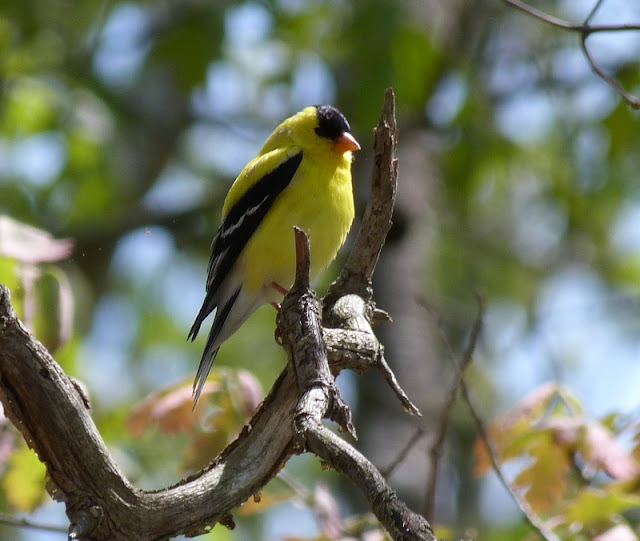Monday morning. Back in the Belleplain once again. Another bash at Prothonotary Warbler. As the Beanery had failed to produce so far, perhaps we'd have more joy around Sunset Bridge and Beaver Dam?
By now the songs of White-eyed and Red-eyed Vireos had
become familiar to our ears. According to Sibley Red-eyed Vireo says ‘Here I am, in the tree...’. Both memorable, repetitive songs were heard frequently as we waited around the muggy, swampy area for Prothon.
Nearby White-breasted Nuthatch was added to the trip list and other stuff noted included Magnolia and Pine Warbler, Blue-Grey Gnatcatcher, Blue Jay and a couple of Eastern Wood Peewee and Acadian Flycatcher.
 |
| Eastern Wood Peewee |
 |
| White-breasted Nuthatch - Photo courtesy Richard Powell |
Later in the morning, a male Prothonotary Warbler was heard calling and then it only goes
and lands in the middle of the road at Sunset Bridge!! Prolonged views of this fine beast
followed as it worked its way up the tree. Stonkonory!!
With the pressure now off, we perused some other spots in the forest. Another White-breasted Nuthatch, Summer Tanager, 4 American Goldfinch, a
Red-tailed Hawk, Wood Thrush, Eastern Phoboe, Yellow-rumped Warbler and
Red-bellied Woodpecker were noted.
 |
| Yank Goldfinch - Image courtesy Richard Powell |
The morning was so enjoyable, that it was about 2.00pm by
the time we returned to the point, where the remainder of the day was spent at
the State Park.
There was a big fall of hirundines including c50 Cliff
Swallows from the Hawk Watch platform. A Cave Swallow had been reported, but we
didn’t manage to pick it out. A 1st summer Bonaparte’s Gull dropped in.
Also noted 11 Glossy Ibis, Ruddy Duck, American Coot,
Tricoloured Heron, Yellow-rumped Warbler and Pine Warbler.
 |
| Northern Mockingbird |
 |
| Least Sand & Semi-P |
Tuesday 14th
May
We were now into the last couple of full days. Beginning at
Higbee, the main highlight of the morning was seeing a Rose-breasted Grosbeak,
male Baltimore Oriole and Blue Grey Gnatcatcher all in the same tree, attracted
by a caterpillar sack. Also Hairy Woodpecker over. We had a conversation with an American birder who was a
moderator of a photograph page on Ebird. Turns out they’ve had problems with a
Brit birder, by the name of ‘Buckeye’,
trolling them. Interesting.
 |
| Rose-breasted Grosbeak - Photo courtesy Richard Powell |
Also noted Black-throated Green Warbler, a couple of Yellow-breasted Chat, Blue Grosbeak, Ruby-throated Hummingbird, Indigo Bunting, Summer Tanager and a fine male American Redstart.
A piece of advice about Higbee Beach by the way. Don’t
venture into the portaloo in the car park. I did and I was mentally scarred.
Talk about TMI written on those toilet walls...
 |
| Ruby-throated Hummingbird |
Two new raptors were also added to the trip list that
afternoon – Broad-winged Hawk at the State Park and American Kestrel over the Beanery.
Sadly, we were not to encounter any Mississippi or Swallow-tailed Kites on this
trip. A Bald Eagle was at the Meadows late afternoon.
 |
| Northern Mockingbird - always at Hawk Watch platform |
 |
| American Robin |
 |
| Eastern Kingbird |
At the Beanery, we were also lucky enough to see yet
another Prothonotory Warbler – this time
a female, which also showed well. Wooohooo! In my top three of American birds for sure.
And the day was not over yet. After the evening meal at the
diner we visited Kimbles Beach Road, where a dusk stakeout gave us a Chuck Will’s
Widow. Big chunky thing, bigger than Nightjar.
Wednesday 15th
May
Final visit to Belleplain and last ditch attempt for Hooded
warbler really. Whilst we had heard them singing a couple of times, they had
remained buried deep within the scrub. Today was no different! Eventually we
managed a couple of crappy flight views. A bird I hope to see much better one
day, but one of the very few disappointments of the trip.
However that was more than compensated by a cracking view of
Louisiana Waterthrush at the same spot, Sunset Bridge. Superb!
Other highlights in the Belleplain that morning included
Downy Woodpecker, Wood Thrush, Red-bellied Woodpecker, White-breasted Nuthatch and
Magnolia Warbler.
Whilst watching a small group of warblers I intercepted a
large tick on my trouser leg. Phew! Actually we’d got off lightly with ticks. I
did find a very small tick attached to my hip one evening and it was very
easily removed. Nothing like Richard’s tick horror story of last year.
In the afternoon it was back to Cox Hall Creek. It was a bit
of a pecker fest with 1 Red- headed Woodpecker, 2 Red-bellied, 1 Downy and
a Northern Flicker.
 |
| Red-bellied Woodpecker - image courtesy of Richard Powell |
Also noted, a first summer male Orchard Oriole, Red-tailed
Hawk and a small flock of flyover Cedar Waxwing.
This Eastern King Snake made us jump! A quick wiki revealed that despite its long length, it is harmless to humans.
 |
| Eastern King Snake |
 |
| Indigo Bunting - better than Reed Buntings |
A final check of Nummy Island later in the afternoon.
Peregrine was added to the list with a distant pair, also Song Sparrow, 2
Black-crowned Night Heron and 1 Tricoloured Heron.
 |
| Also a pair of American Oyc & with chicks |
The 16th was the travel back to Philly day, before
an evening flight back to the UK. A final stop at Heislerville on the way out.
Two final trip ticks – Greater Scaup and Ring-billed Gull.
 |
| The last Least Sandpiper |
Cape May. Loved it. Got the t-shirt and a cap. I can highly recommend
this trip to any UK birders!
Happy to supply further info to anyone interested in making the trip.
















